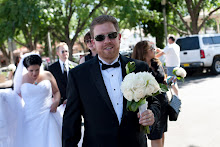 |
| May 20th annular eclipse |
This year was the first time since 1994 that an annular solar eclipse was visible in the continental US. An annular solar eclipse is when the moon passes between the Earth and Sun, but the apparent diameter of the moon is smaller than the Sun so a ring, or annulus, appears. Albuquerque was one of the best places to see this eclipse, falling almost directly on the center line of the shadow's path. The other unique aspect of this eclipse, besides the annular shape, was the time of day that the eclipse occurred. The show started about 6:30pm local time, but because of the duration, the sun was still obscured during the sunset.
 |
| The May 20th, 2012 annular eclipse path |
I knew I had to get some images of this rare occurrence, but without proper protection for the camera, the sun can damage the components inside, just as it can damage a person's eyes if you look directly at it. They make special filters for cameras and telescopes that block out the majority of the energy, but after doing some research I also found out you can use welder's filter glass as a substitute for these filters, and it is cheap! Everything I read said to use a #14 welder's filter (the strongest), but after looking at comparisons and not finding any #14 in stock anywhere, I decided I could get away with #12 welder's glass.
 |
| I used electrical tape to attach the welder's glass I bought to an old 77mm filter ring I had laying around so I could attach it to my camera |
I spent a fair amount of time doing research and looking at images of past eclipses, and decided I wanted something more unique and creative than a simple telephoto shot of the annular sun against a black background. I really enjoy creating timelapses, because I think they are powerful at conveying a sense of time and story, and while they take a lot of planning and work, the end result leaves me with a sense of satisfaction. The plan was to do a series of images to create a composite "timelapse" shot of the event after the fact, and also grab some landscape images in between the shots if I could manage.
 |
| The setup in the foothills of the Sandia mountains |
Terah and I decided to make a date out of the evening and picked up some bbq and beer and headed up to the foothills to find a spot. It was packed! All kinds of people were out and about, with tripods and telescopes and homemade viewers and everything in between setup. Eventually we found a decent spot on a hillside looking west.
 |
| The view from our spot. I was worried about the hill on the right blocking the end of the eclipse, which it did, but it turned out to be a good thing |
I used a intervalometer remote attached to the camera to take my sequence of images. I started 3 minutes before the start of the eclipse, and took an image every two and a half minutes. The filter I made did a good job of blocking the light, giving me exposures at ISO100, f11 of 1/1000 of a second.
 |
| The final composite sequence of the May 20th, 2012 eclipse |
In the final composite sequence image I put together, I ended up not using every image I took, it was too cluttered for my liking with a shot every two and a half minutes, so it shows the sun at five minute increments. We had a lot of time to waste, so I did some experiments using my iphone camera:
 |
| iphone shot, notice the small eclipse shaped reflection |
 |
| iphone shot using the welder's glass filter to shoot through |
 |
| iphone shot, taken when the full annulus was showing, which shows up in the reflection on the right |
I did switch over to my telephoto lens several times during the eclipse to get a few zoomed in shots of the eclipse, mainly during the full annular duration. Because I don't have a 2nd body, this was a fun excercise in frantic lens swapping that Terah helped with. We were able to do it within the two and a half minutes between sequence shots without moving the sequence tripod at all!
 |
| I knew going in silhouette images would be my best bet, and they didn't disappoint |
The hill I was worried about when we first set up at our spot turned out to be a blessing. It was obvious as the eclipse continued that the hill would block a portion of the event from where we were, but when that happened I switched to my telephoto lens and was able to get some great shots of the watchers up on the ridge.
 |
| Lots of activity up on the ridge |
 |
| A few remain on the ridge as the eclipse starts to set |
Eventually we headed down the hill and back towards our home, and with the unobstructed view of the horizon, we got one last peak at the setting eclipse sun.
 |
| Goodbye Mr. Eclipse |
It was such an awesome experience shooting and watching the eclipse on May 20th. Definitely lucky to have been in the path for this one, I know lots of friends who weren't so lucky. The good news is, in 2017 a total eclipse will be visible over large portions of the continental US, with prime viewing locations in the rocky mountain and great plains regions, so make your plans now!















No comments:
Post a Comment